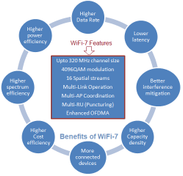Understanding NFC: Tags, Chips, and Applications
Advertisement
This article explains NFC (Near Field Communication) technology found in mobile phones, detailing its uses and features.
NFC utilizes a tag or chip within the mobile phone to enable short-range wireless communication. NFC stands for Near Field Communication. This technology facilitates communication between wireless devices over a very short distance (approximately 4 inches). Smartphones equipped with NFC tags can exchange information with a simple tap.
Applications of NFC
Beyond simple data exchange, NFC has a variety of applications, including:
- Online payments
- E-ticket booking
NFC Technology Features
Here are some key technical specifications of NFC:
- RF Carrier Frequency: 13.56 MHz
- Bandwidth: 14 KHz
- Communication: Two-Way Communication
- Data Rate: 106 Kbps, 212 Kbps, 424 Kbps
- Applications: Online payments, E-Ticket Booking
![]() Image: NFC icons
Image: NFC icons
Many modern smartphones, including Google Nexus, Apple iPhones, HTC phones, and BlackBerries, incorporate embedded NFC tags. The image above shows common NFC icons found on NFC-enabled devices. These icons indicate NFC compliance.
What You Can Do with NFC
Here’s a breakdown of the functionalities available with an NFC chip or tag on your phone:
- Data Communication: Transfer data between two nearby mobile devices.
- Programmable Commands: Program commands directly onto the NFC chip, allowing the phone to perform specific actions based on the NFC device’s programming.
- Payments: Make payments at parking meters and retail locations.
- Ticketing: Use it as a ticket and boarding pass for airlines and buses.
- Access Control: Open doors in offices using NFC-compliant security badges, enhancing security.
- Automotive: Some car manufacturers, like BMW, provide NFC-enabled keys.
Advertisement
 RF
RF

